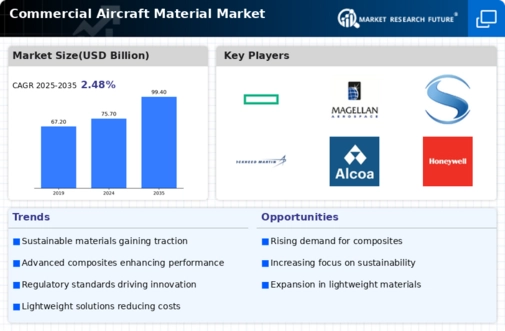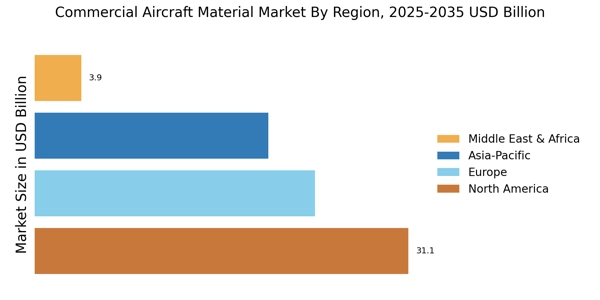The Commercial Aircraft Material Market is currently characterized by a dynamic competitive landscape, driven by technological advancements, sustainability initiatives, and increasing demand for fuel-efficient aircraft. Major players such as Boeing (US), Airbus (FR), and Raytheon Technologies (US) are at the forefront, each adopting distinct strategies to enhance their market positioning. Boeing (US) focuses on innovation in composite materials to reduce aircraft weight, while Airbus (FR) emphasizes partnerships with material suppliers to ensure a sustainable supply chain. Raytheon Technologies (US) is investing heavily in digital transformation, integrating AI and data analytics into their manufacturing processes, which collectively shapes a competitive environment that prioritizes efficiency and sustainability.
The market structure appears moderately fragmented, with key players employing various business tactics to optimize their operations. Localizing manufacturing has become a prevalent strategy, allowing companies to mitigate supply chain disruptions and reduce costs. This approach, coupled with supply chain optimization, enhances the resilience of these firms in a competitive landscape where agility is paramount. The collective influence of these major players fosters a competitive atmosphere that encourages innovation and collaboration.
In August 2025, Boeing (US) announced a strategic partnership with a leading materials science company to develop next-generation lightweight composites. This collaboration is poised to enhance Boeing's capabilities in producing more fuel-efficient aircraft, aligning with the industry's shift towards sustainability. The strategic importance of this partnership lies in its potential to significantly reduce the overall weight of aircraft, thereby improving fuel efficiency and lowering operational costs for airlines.
In September 2025, Airbus (FR) unveiled a new initiative aimed at increasing the use of recycled materials in its aircraft manufacturing processes. This initiative not only underscores Airbus's commitment to sustainability but also positions the company as a leader in environmentally responsible aviation. The strategic significance of this move is profound, as it may set a new industry standard for material sourcing, compelling competitors to follow suit in order to maintain market relevance.
In October 2025, Raytheon Technologies (US) launched an advanced AI-driven analytics platform designed to optimize supply chain management for aircraft materials. This platform aims to enhance predictive capabilities, allowing for more efficient inventory management and reduced lead times. The strategic importance of this development lies in its potential to revolutionize how materials are sourced and utilized, thereby increasing operational efficiency across the industry.
As of October 2025, the competitive trends in the Commercial Aircraft Material Market are increasingly defined by digitalization, sustainability, and the integration of AI technologies. Strategic alliances are becoming more prevalent, as companies recognize the need for collaboration to drive innovation and meet evolving regulatory standards. Looking ahead, competitive differentiation is likely to shift from traditional price-based competition to a focus on technological innovation, sustainable practices, and supply chain reliability, indicating a transformative phase for the industry.


















Leave a Comment